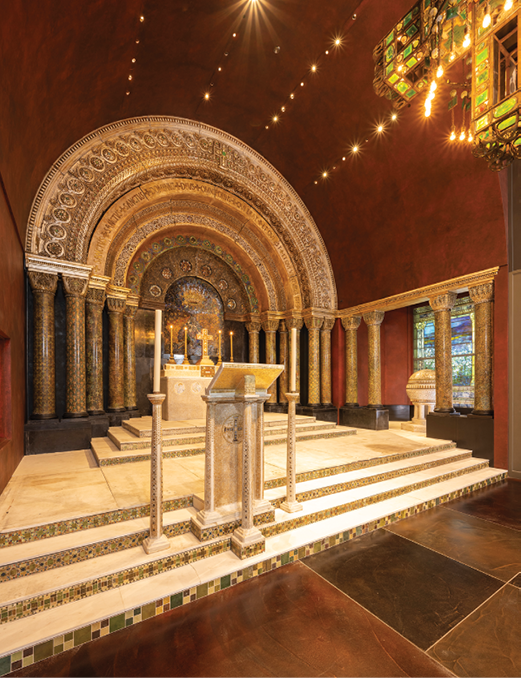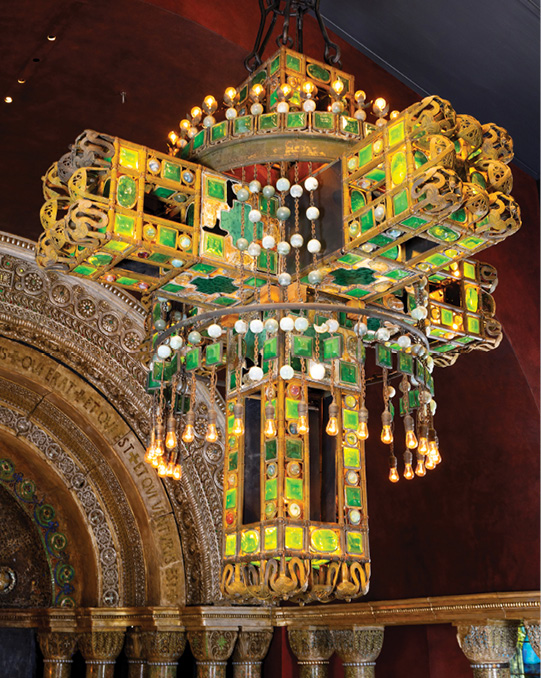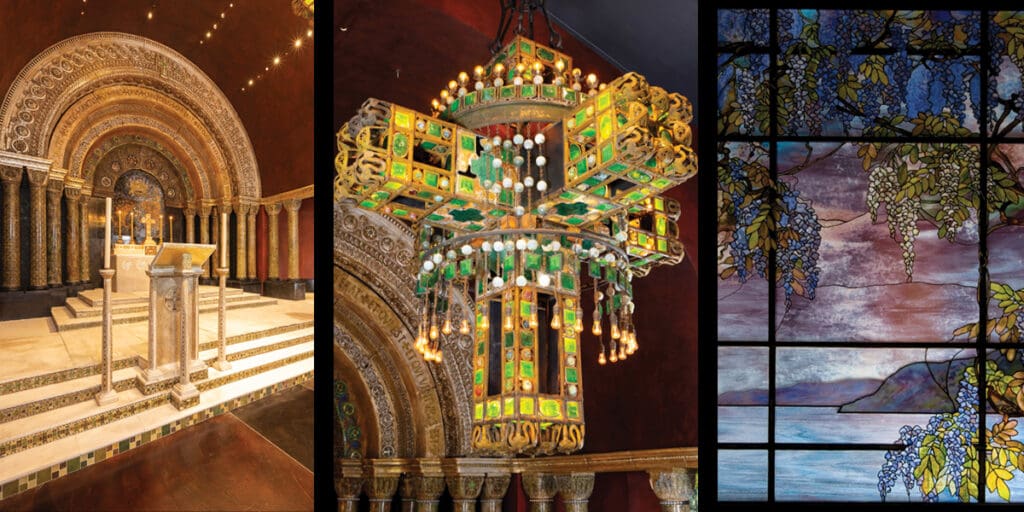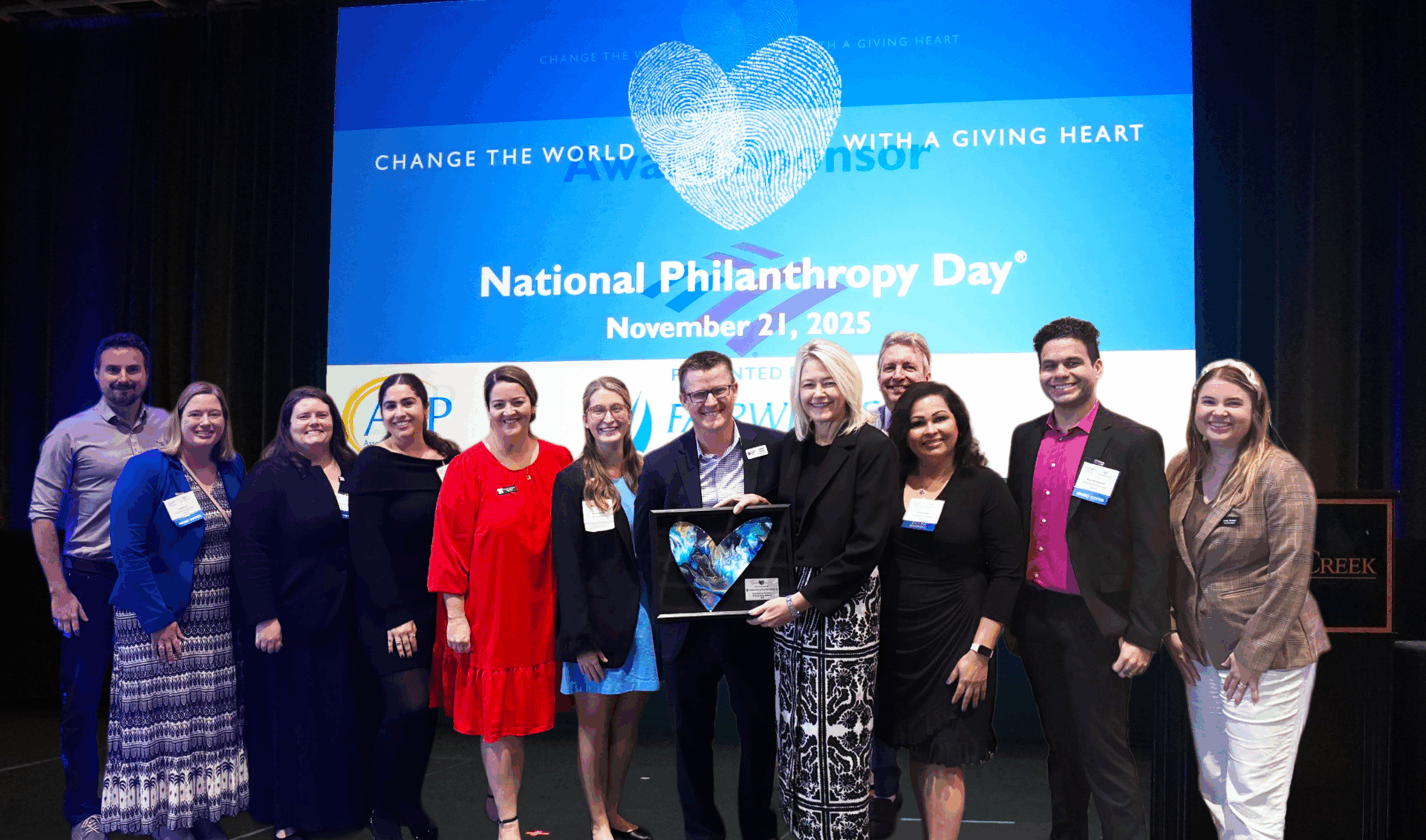Tiffany’s chapel made a long, strange trip to Winter Park.
By Randy Noles
The 1893 World’s Columbian Exposition in Chicago—also known as the Chicago World’s Fair—saw the debut of the Ferris wheel. Less over-the-top (but not by much) was a small jewel-box of a chapel interior designed by an artist named Louis Comfort Tiffany.

The elaborate 800-square-foot showpiece established Tiffany Glass and Decorating Company as the country’s premier studio specializing in art glass and architectural décor.
After the fair, the chapel was dismantled and hidden away for more than 100 years only to be rescued, reassembled and restored for The Charles Hosmer Morse Museum of American Art, where it was again opened to the public in 1999.
“Like a cat, this chapel seems to have had nine lives,” says Jennifer Thalheimer, the museum’s director, who will oversee a celebration of the born-again chapel’s 25th anniversary in Winter Park.
To mark the occasion, the museum will display a monumental mosaic, Fathers of the Church, as well as other surviving elements of the fair. The mosaic was the first to come out of Tiffany Studio’s newly formed Women’s Glass-Cutting Department.
Fathers of the Church—crafted by a cadre of self-styled “Tiffany Girls”—will be on loan from the Neustadt Collection, a nonprofit decorative-arts archive based in New York that owns hundreds of Tiffany lamps and windows and the world’s largest trove of glass fragments from Tiffany Studios.
In addition, the museum will bring back a Tiffany window, View of Oyster Bay, that it had loaned to the Metropolitan Museum of Art in New York City, where it became a beloved part of the American Wing. The wing will be undergoing renovations next year, so it was an opportune time to bring it back to Central Florida.
Tiffany—who enjoyed a surge in residential commissions after the fair—designed the 5-by-6-foot window for a Manhattan townhome owned by industrialist William C. Skinner. Scholars say the artist likely borrowed a similar view from his own studio and added purple wisteria to this art-glass masterpiece of blues, lavenders and greens.
A concurrent exhibition, After the Fair, will trace the hair-raising journey of the chapel (and the window, for that matter) from the Windy City to the City of Culture and Heritage. Museum members may attend a reception on Monday, October 14, to celebrate the opening of the exhibition, which will remain on view throughout 2025.

Here’s the story in a nutshell (made of glass). The chapel was disassembled following the fair and moved into a dank subbasement of the still-under-construction Cathedral of St. John the Divine in New York City. It was to be placed in the main church, but new architect Ralph Adams Cram (also the designer of Knowles Memorial Chapel at Rollins College) changed the style to gothic—the very antithesis of everything Tiffany.
So the chapel remained in the basement and fell into disrepair before Tiffany reclaimed it in 1916 and reassembled it in an outbuilding at Laurelton Hall, his estate on Long Island. After Tiffany’s death in 1933, the estate was unfortunately poorly maintained under the auspices of the Louis Comfort Tiffany Foundation.
A disastrous fire destroyed Laurelton Hall’s main building, but spared the chapel, in 1957. By then, however, Tiffany’s work had been so maligned by the art world’s cognoscenti that it was considered virtually worthless. Many chapel elements had been removed years before and were in the hands of collectors around the country.
What was left of Laurelton Hall—and the treasures it still contained—was set to be razed. Hundreds of stained-glass windows (including View of Oyster Bay) and architectural elements would have been scrapped and lost forever had Hugh and Jeannette Genius McKean not intervened.
For Hugh, then president and previously a professor of art at Rollins College, it was a personal matter. In 1930 he had earned a Tiffany Fellowship and spent two heady months at Laurelton Hall, where aspiring artists could live and work in an unstructured but inspirational setting under the tutelage of Tiffany himself.

Jeannette was also an artist and—conveniently, as it turned out—heiress to the fortune left by her grandfather, Charles Hosmer Morse. She was as eager as her husband to salvage as much as they could from the ruins and truck everything to Winter Park, where it could be displayed in the Morse Gallery of Art, then located on the campus of Rollins.
“I shook something against a tree,” McKean wrote in his book The Lost Treasures of Louis Comfort Tiffany (Doubleday, ١٩٨٠). “It rattled. The head of the wrecking company waiting to clear the property was with us. I asked him what it was. ‘That’s one of the old man’s windows,’ he replied.”
And not just any window. It was one of the Four Seasons windows, created in 1900 for the Exposition Universelle in Paris. Seeing this quartet of magnificent, fully restored panels today, it’s almost beyond belief that they were once regarded as little more than trash.
The McKeans, using a small fleet of rented moving vans, loaded and transported what would become the core of the museum’s collection—including most of the chapel interior. The chapel elements were stored in a maintenance shed in the Genius Preserve, a lush 48-acre site owned by the Elizabeth Morse Genius Foundation (named for Jeannette’s mother).
Only a fraction of the salvaged collection could be displayed until 1995, when the Morse Museum—which in 1977 had changed its name and moved off-campus to a 6,000-square-foot building on East Welbourne Avenue in downtown Winter Park—opened in a new building on Park Avenue that measured 16,000 square feet.
And the chapel couldn’t be displayed at all until that new building was expanded by an additional 4,300 square feet in 1999 specifically for that purpose. (It was expanded again in 2011 and is today more than 40,000 square feet.)
Between 1995 and 1999, artisans and conservators had painstakingly restored the chapel’s elements, with much of the work taking place in the museum’s prior Welbourne Avenue location—where some project participants actually moved in and slept on cots—and then pieced them together in the new space. The project was a marvel of both arts and engineering.
Jeannette had died in 1989 and Hugh had died just months after the new building was completed. Sadly, neither lived to see the reconstituted chapel in all its Byzantine–Romanesque glory. But they would surely be pleased that we got to enjoy it.
The Charles Hosmer Morse Museum of American Art is located at 445 North Park Avenue, Winter Park. For more information, call 407.645.5311 or visit morsemuseum.org.




